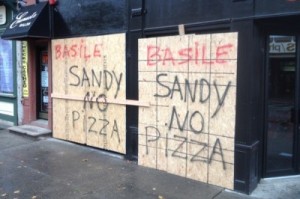After barfing for the sixth time, Sorenne has fallen back to sleep beside me on the couch, around 4 a.m.
For the second time this year, it appears like it’s classic foodborne illness, which means I’m wracked with guilt. I buy the food; I prepare the food; I make Sorenne’s  lunch; I nag at the school about petting zoos and handwashing. And I got a PhD in this stuff.
lunch; I nag at the school about petting zoos and handwashing. And I got a PhD in this stuff.
So it’s probably my fault.
I still marvel that epidemiologists and public health types and are able to pinpoint the source of any foodborne illness, especially the obscure ones, and can apparently separate rigorous investigation from emotional tug strings.
Michéle Samarya-Timm, a registered environmental health specialist with the Somerset County Department of Health in New Jersey and one of those health types I’m thankful for, writes that Thanksgiving is more than eating. As noted in 1973 by Charlie Brown. We should just be thankful for being together. I think that’s what they mean by ‘Thanksgiving.’
This is the time of year to reflect and appreciate life’s blessings. For some families, this holiday is anything but traditional. Nearly 4 weeks after Hurricane Sandy left a path of destruction in the northeast, there’s a lot to think about, but there’s also much to be thankful for.
Thousands of folks were hit hard by this Frankenstorm, and still have challenges ahead. Despite the stereotypes promoted by television, folks in New York and New  Jersey are among the most resilient around. among other things, they turned to MREs as a solution to food supply and food safety problems. Warm, safe food in an empty stomach truly fosters a feeling of thanks.
Jersey are among the most resilient around. among other things, they turned to MREs as a solution to food supply and food safety problems. Warm, safe food in an empty stomach truly fosters a feeling of thanks.
The Meal, Ready-to-Eat – commonly known as the MRE or heater meal – is a self-contained, individual buffet of food. Shelf stable, the packaging is required to maintain a minimum shelf life of three and a half years at 27 °C (81 °F), nine months at 38 °C (100 °F), and short durations from −51 °C (−60 °F) to 49 °C (120 °F). Unopened, they can be tossed around or dropped like a Bowl-Game football without damage — MREs are designed to withstand parachute drops from 1,250 ft, and non-parachute drops of 98 ft.
Spreading the warmth is made easy — MREs come packaged its own method of heating. The flameless heater uses a simple chemical reaction to provide sufficient energy to warm the food – 165ºF is the standard – in a nearly foolproof way (if you follow the easy directions, that is).
These culinary delights are a blessing when there is no power, no unspoiled fresh food, no [legally] open restaurants, and when the Doritos and canned beans have run out. Unlike the packaged rations of Grandpa’s day, these MREs have a reasonable menu selection – like roast beef, vegetable lasagna, and Ratatouille. And during natural disasters, anything that comes with a serving of chocolate is welcome.
Luckily, MREs are NOT on the menu here tomorrow. On a sheltering oversight call this morning, the American Red Cross assured that a traditional Thanksgiving meal – turkey, mashed potatoes and stuffing — will be provided on all their feeding routes tomorrow.
Much gratitude to them and all the folks who stepped up to supply, feed, and serve the victims, responders, and public health professionals. Everyone brought their A-game, and these folks continue to assure food is readily available and safe.
In the aftermath of disaster, and on a routine day, food safety is assured by many dedicated professionals, who truly deserve our thanks.
At the table this year, let’s echo Peppermint Patty — Are we going to have a prayer? It’s Thanksgiving, you know.


